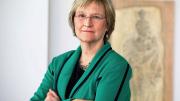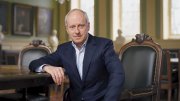“The artist is always working with mingled gladness and disappointment towards an ideal he never attains. It is his struggle toward that ideal which makes his life a happy one.” — President Charles W. Eliot
It’s been quite a year so far for Harvard artists working in television and film. Nick Britell put glorious music to Moonlight, John Lithgow brought Winston Churchill to roaring life in The Crown, and Natalie Portman embodied desperation and grief in Jackie. The musical La La Land, written and directed by Damien Chazelle, was the recipient of seven Golden Globe awards, including Best Original Score and Best Original Song accolades for his classmate Justin Hurwitz. When this column goes to print, I will be eagerly waiting to see how many of our Academy Award nominees—five by my count—take home Oscars for their extraordinary contributions.
These alumni represent a broad and deep current of creativity and commitment that runs through the University, expanding the lives of students engaged in arts practice and enriching the experiences of members of our community who, like me, are profoundly moved by their talents. There is perhaps no better—and certainly no more concentrated—celebration of their work than ARTS FIRST, a weekend-long festival that this year marks its 25th anniversary. Championed and launched by John Lithgow, it has shined a light on a remarkable diversity of talent and, since 1995, has featured the presentation of the Harvard Arts Medal to an individual who has demonstrated excellence, achieved distinction, and advanced the arts. Past awardees include actors, architects, authors, conductors, composers, dancers, filmmakers, musicians, playwrights, poets, and visual artists—an extraordinary company that embodies the promise of artistic pursuits among members of the University community.
Elevating arts practice and performance—and acknowledging their unique abilities to bring forth new and vital ideas—is an ongoing aspect of nurturing the very skills and habits of mind that are essential to meet the challenges of our age. A new undergraduate concentration in theater, dance, and media harnesses and integrates existing Harvard strengths, and it places the practice and study of art in the heart of the University’s curriculum. The Learning From Performers program continues to host artists and art ensembles on campus. Over the past ten years, more than 225 distinguished guests have engaged directly with students and faculty, as well as the public, through discussions, seminars, workshops, and master classes, as well as exhibitions and performances.
Creating connections and providing support for would-be artists is an important component of preparing students to pursue their interests after graduation. With the help of Office for the Arts’ Artist Development Fellowships, undergraduates are able to make great leaps in their artistic growth in a variety of ways—from apprenticing an acclaimed artist to undertaking critical research in service of an ambitious goal, to studying at a major music, dance, or theater festival. Each spring, I meet with the newest cohort of fellows and hear firsthand about summer plans that take them around the globe and into worlds that they could not have imagined. They’ve undertaken, among many other projects, a public art piece at the annual Burning Man Festival, an animated documentary about American beatbox culture, a collection of non-fiction stories about pilgrimage in India, and intensive dance, music, and theater study and performance. Recently graduated fellows are now working with organizations including the Los Angeles Ballet, the Los Angeles Opera, the Paul Taylor Dance Company, and the San Antonio Symphony, as well as crafting novels, choreographing theater productions, and writing for television.
Two years before he so eloquently described the aspirations of the artist, my predecessor Charles W. Eliot praised the expanding recognition of “new varieties of constructive imagination,” noting happily that the practical work of engineers and scientists had come to garner the same “high admiration” previously reserved for the labors of “the poet, artist, or dramatist.” His words are a reminder to me that the work of teaching and learning to which we dedicate ourselves can be reconsidered and revised in every age, that the ideal of Harvard will always inspire effort—and no small measure of art, beauty, and happiness.








